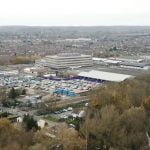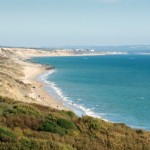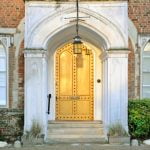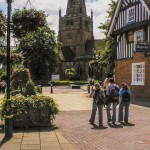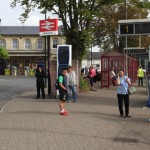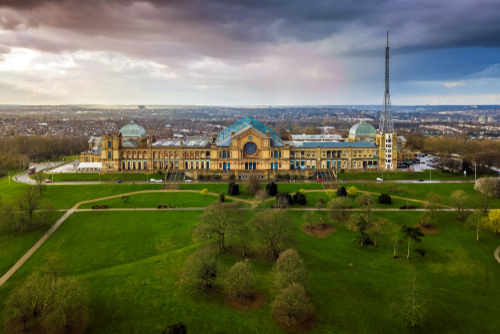
A quick guide to the London Borough of Haringey
Overview
The London Borough of Haringey is situated in the north of Greater London. The borough is sometimes designated as being part of Inner London, but more usually as being part of Outer London. It was created in 1965 by the merger of the 3 Municipal Boroughs of Hornsey, Wood Green and Tottenham, which had all previously been part of Middlesex. It shares borders with six other London boroughs, Enfield, Waltham Forest, Hackney, Islington, Camden, and Barnet. The most famous landmarks in the borough would include Alexandra Palace, Bruce Castle and the Tottenham Hotspur Stadium (formerly White Hart Lane). Haringey covers an area of just under 29 sq. km, which includes a large number of parks and open spaces that makes up more than 25% of the borough’s total area. At the 2011 UK Census, the borough had a population of 254,926.
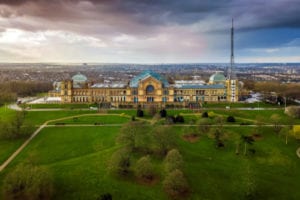
Alexandra Palace – a major tourist attraction in Haringey
A Very Brief History
There is archaeological evidence of both Stone Age and Bronze Age activity in the Haringey area. Around the 1st century BC, the Trinobantes, a Celtic tribe, were the next people to inhabit the area. They were followed by the Romans, who eventually settled in the area around the mid-1st century AD. Their activity is largely evident by the roads they built through the area. Today’s Tottenham High Road formed part of one of the best-known Roman thoroughfares in Britain; Ermine Street.
In the 5th and 6th centuries, the Saxons carried out constant invasions of the area. One of their chieftains; ‘Haering’, eventually settled in the area, probably at Hornsey. The local place names of Haringey, Harringay and Hornsey are all variations of the same Old English phrase; ‘Hæringeshege’, which translates to modern English as Hæring’s enclosure.
During the Middle Ages, two large manors in the area we now know as “Haringey” were established, which were Hornsey and Tottenham. By 1300, the manors had become parishes, with firm boundaries. Around the same period, the total population of the Tottenham area was recorded as being just 66 people, consisting of 59 serfs, 4 slaves, 2 freemen and a priest.
Haringey remained a rural area until the 18th-century when it became an increasingly popular base, from which the well-to-do could easily commute from to London. The coming of the railways in the mid-nineteenth century led to the rapid urbanisation of the borough. In the decade between 1851 and 1861, the population of Haringey had increased by almost 300%, from 8,762 to 34,651. By the turn of the century, much of Haringey had been transformed from a rural to an urbanised environment. In 1901 UK census, the population was recorded as 204,226.
Although Haringey is largely residential, it has a number of industries, most of which are located in the Tottenham area. These include light engineering and the manufacture of metal goods, confectioneries, furniture, clothing, and footwear. Wood Green is a centre for shopping and services and is the administrative centre of the borough. Alexandra Palace, with its surrounding park, was built in the late 19th century as an art and recreation centre. It was often referred to as the ‘People’s Palace’ or affectionately by Londoners as ‘Ally Pally’. In 1936, the Palace became the new home of the British Broadcasting Corporation (BBC). In 1980, just six months after the transfer of the trusteeship of the Palace to Haringey Council, it suffered a major fire. It was eventually restored to its former glory 8 years later and now serves the borough as an exhibition and conference centre.
Haringey’s ethnic minorities make up more than one-third of the population, with the largest groups being Afro-Caribbeans and Africans.
In terms of twinning, Haringey has cultural and civic links with a good number in the Caribbean and Europe, which are Arima (Trinidad & Tobago), Clarendon (Jamaica), Holetown (Barbados), Larnaca (Cyprus), Livy-Gargan (Paris, France), Sundbyberg (Sweden), Jalasiarvi (Finland) and Koblenz (Germany).
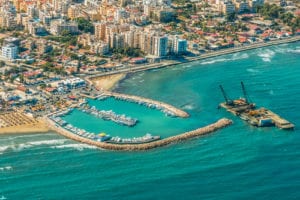
Larnaca in Cyprus is twinned with Haringey
Getting Around!
Unless absolutely necessary, driving in the Greater London Area is generally not recommended due to restricted parking facilities, potentially for additional charges and the ability to get lost. You can get most easily get to/from and around Haringey by Train, Bus or Tube. Buses are generally the cheapest form of transport but the train or tube generally offer the speediest way of getting around, especially for longer journeys.
Train
The National Rail, London Overground and London Underground stations in the borough are:
National Railway Stations
- Alexandra Palace
- Bowes Park
- Harringay Green Lanes
- Harringay
- Hornsey
- Northumberland Park
- Tottenham Hale
Underground (Tube) Stations
- Bounds Green
- Bruce Grove
- Highgate
- Manor House
- Seven Sisters
- Tottenham Hale
- Wood Green
London Overground Stations
- Seven Sisters
- South Tottenham
- White Hart Lane
Things to see and do!
Parks and open spaces
- Parkland Walk – One of London’s best-known trails, over 5-miles long, with parkland and nature reserves
- Alexandra Park, London – parkland with tree-lined jogging paths, a boating lake, kids’ playgrounds & resident fallow deer.
- Highgate Wood – 28 hectare ancient urban woodland with trails, sports fields, café & playground
- Finsbury Park – Urban park with American gardens, athletics track and boating lake
- Queen’s Wood – 21 hectares of ancient woodland
- Tottenham Marshes – Large expanse of public grassland encompassing wildflower meadows, scrubland, waterways and a lake
- Trent Park – Vast parkland of woodland and lakes, once a royal hunting ground, now used for leisure activities
- Priory Park – 6.5 hectares of open space for sport and recreation, a cafe and formal 19th-century Italian gardens
- Lee Valley Regional Park – Open spaces and sports venues comprising a 26-mile-long, 4,000-hectare park
- Markfield Park – Riverside park featuring a large open lawn as well as a walking path, cafe & steam-engine museum.
- Coldfall Wood – 14 hectares of ancient wood in Muswell Hill
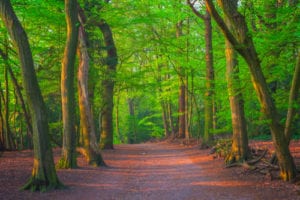
Highgate Wood in the Borough Haringey
Tourist attractions
- Alexandra Palace – Iconic Victorian building in parkland staging live music, sports, exhibitions, circus and funfairs
- Bruce Castle Museum – Local history exhibits in 16th-century manor house with a parkland setting
- Markfield Beam Engine and Museum – Rare surviving Victorian steam-powered beam engine displayed in its restored original engine house
Tottenham Hotspur Football Club
Tottenham Hotspur play their football in the English Premier League (EPL). Commonly referred to as ‘Spurs’, the club’s home ground is now the Tottenham Hotspur Stadium, which is situated on Tottenham High Road. Spurs have been based at the same ground since 1899 and until very recently it has been much better known as White Hart Lane. However, in 2017, the old ground was demolished to make way for the new stadium, which officially opened in January 2019. Pre-booked 90-minute guided tours of the ground are available on selective days, which excludes match days.
Famous People
Well-known people who were born, have lived, or are living in the Borough of Haringey, include:
- Adele (Adele Adkins) – Contemporary world-renowned singer and songwriter
- Jack Hawkins – Highly acclaimed English actor of stage and film, 1930s – 1970s
- Luke Howard – A renowned chemist, known as the ‘Father of Meteorology’
- Samuel Taylor Coleridge – Renowned 18th/19th-century English poet, literary critic, philosopher and theologian
- J. B. Priestley – English novelist, playwright, screenwriter, broadcaster and social commentator of the 20th century
- Yehudi Menuhin – American-born virtuoso violinist and conductor
- Sting (Gordon Sumner) – Contemporary world-renowned singer and songwriter
- George Michael – Late contemporary world-renowned singer and songwriter
- Ho Chi Minh – Vietnamese revolutionary and politician, served as PM & President of North Vietnam (1945 -1969), lead the fight for independence
- Sir John Betjeman – 20th-century poet Laureate, lived in the West Hill as a child
Did you know?
- Karl Marx, the author of ‘Das Kapital’ and thus considered the Father of Communism is buried in Haringey’s Highgate Cemetery
- Haringey has one of the most diverse populations in the UK, an estimated 193 languages are spoken in the borough
- Spurs legend, Jimmy Greaves, despite retiring in 1972, is still by far the most prolific goalscorer ever in the top flight of English football
- Renowned 18th/19th-century poet, Samuel Taylor Coleridge, who once resided in Haringey was an opium addict
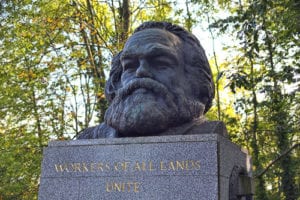
Karl Marx is buried in Highgate Cemetery Editorial Credit: Tony Baggett/Shutterstock.com
Where to stay?
There is a good choice of hostel-style accommodation in or close to the Borough of Haringey. There’s also plenty of B & B/Guesthouse/Basic Hotels style accommodation on offer. If you’re looking for a bit more luxury then there’s also plenty 3 and 4 hotel-style accommodation. Haringey is pretty competitive on price when looking across the Greater London Area as a whole. An alternative to a hotel would be to rent an apartment – most have no minimum let period. While the majority of apartments cater to couples, some can accommodate up to 6 people. Indicative prices for the most readily available types of accommodation/per night, based on 2 adults sharing, unless otherwise indicated, are as follows:
Hostel: £25 – £40 (1 or 2 people sharing)
B & B/Guesthouse/Basic Hotel: £40 – £75
3/4 Star Hotel: £75 – £150
Apartments vary greatly based on no. of available berths, location and standard
If you enjoyed this London guide, check out some of our other London guides by clicking the link below.
